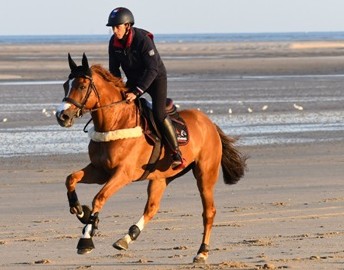How to Create Exercise Routine for Horses: FLAIR Strips
 Just as professional athletes stick to routine workouts and training programs to stay up to par with their demanding competitive environments, equine athletes require the same sort of time and commitment for developing their performance abilities.
Just as professional athletes stick to routine workouts and training programs to stay up to par with their demanding competitive environments, equine athletes require the same sort of time and commitment for developing their performance abilities.
Regardless of the discipline, having working knowledge of how to assess, monitor, and develop a horse’s strength and endurance is vital for any rider wanting to succeed in equine sports. Once you have set your goals, it's critical to design a realistic conditioning program for your horse.
When constructing your program, it is important to keep in mind:
- Your horse’s age, breed, and any sort of injuries/rehab requirements.
- The type of sport and level at which you wish to compete in.
- Your own fitness and commitment to training with your horse.
Once you have established both you and your horse’s goals for the season, you can start drawing up the blueprints for how and when you will work to fulfill them.
Broadly speaking, there are three different fitness categories that should be woven into your horse’s workout schedule.
- Cardiorespiratory improves heart and lung functioning as well as the delivery of oxygen to the muscles.
Cardiorespiratory exercises include: speed play, which focuses on controlled acceleration and partial recovery; interval training, which mixes both canter and walking exercises (ex. two minutes of canter, two minutes of walking – increasing the interval slowly to 3:3, 4:4, 5:5 minutes, etc.); and hill training, which should include walking and steady trotting up an incline (ex. trotting the first half and walking the top half).
- Strength develops muscle endurance (specific to different equine sports).
Strength training, for dressage and endurance horses, should focus on long duration (high repetitions) at low intensity, while jumping and western horses see greater benefits from low repetitions of high- intensity exercise. It is important to know that after an intense strength training session, many horses require two to three days of active recovery (slow distance training).
- Suppling works toward increasing joint motion and flexibility, which in turn, reduces the risk of injury.
Suppling exercises should take form through slow, controlled movements to the natural limit of a joint or structure (ex. carrot stretches, back lifts, and limb stretches). In contrast, dynamic suppling should focus on active muscular contraction through weight bearing, long/low stretching, trotting poles, and lateral work.
Equine exercise and breathing go hand-in-hand – a horse that is able to breathe easily will be the one to perform more efficiently.
